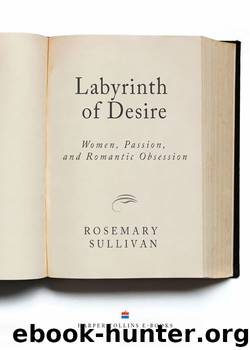Labyrinth of Desire by Rosemary Sullivan

Author:Rosemary Sullivan [Sullivan, Rosemary]
Language: eng
Format: epub
ISBN: 978-1-443-40366-5
Publisher: HarperCollins Canada
Published: 2010-06-14T16:00:00+00:00
It’s hard to remember that sexuality is a construct, that the idea of the body changes. Before the middle of the eighteenth century (the century variously called the Age of Enlightenment and the Age of Reason), it was believed that male and female bodies were essentially the same, though the female was less perfect. According to the literary historian Thomas Laqueur in his book Making Sex, Galen, the second-century Greek physician and writer on medicine, had developed a powerful model of the human body that demonstrated that male and female reproductive organs were identical: “women were essentially men in whom a lack of vital heat—of perfection—had resulted in the retention, inside, of the structures that in the male are visible without.” The externalized sexual organs of the male could all be found in the female, but inside: the vagina was an interior penis, the labia was a foreskin, the uterus a scrotum, and the ovaries were testicles. (In fact the ovaries were called by the same name as male testicles.)
You can see where this is leading. If men ejaculated seed, so did women. If men needed orgasm to come, so too did women. Women might have been seen as less perfect, but if a man wanted progeny, he had better learn how to please his wife.
Galen was translated into Latin during the eleventh and twelfth centuries, and his writings dominated the development of medieval medicine. Laqueur explains that almost every manual on midwifery or marriage (and these existed in all the European languages) “reported it as a commonplace that ‘when the seed issues in the act of generation [from both men and women] there at the same time arises an extra-ordinary titillation and delight in all the members of the body.’” The manuals, of necessity, included advice on how to sexually stimulate women to come to orgasm, since without orgasm women could not conceive.
But the Age of Enlightenment made the discovery that the sexes were opposites. Women were alien creatures, intrinsically different from men. This was not a consequence of new medical knowledge. “Sometime in the eighteenth century,” Laqueur writes, “sex as we know it was invented.” The context was political. In the Age of Reason, it was no longer reasonable to argue that women were inferior because they were a lower form of nature. A new rationalization for the power relationship between the sexes had to be found. Women’s bodies became the arena of control: “Women owe their manner of being to their organs of generation, and especially to the uterus,” as the eighteenth-century physician C.M. Gardien put it. The orgasm needed for ejaculation and, therefore, for reproduction became an exclusively male phenomenon.
In this way, the rights of women to sexual pleasure were slowly eroded until all forms of female eroticism began to be viewed with deep suspicion. By the end of the eighteenth century it was believed that most women didn’t have sexual feelings. By the Victorian era, decent women showed no signs of erotic response. They were
Download
This site does not store any files on its server. We only index and link to content provided by other sites. Please contact the content providers to delete copyright contents if any and email us, we'll remove relevant links or contents immediately.
| Crime & Criminals | LGBT |
| Special Needs | Women |
We're Going to Need More Wine by Gabrielle Union(19002)
Pimp by Iceberg Slim(14433)
Bombshells: Glamour Girls of a Lifetime by Sullivan Steve(14020)
The Radium Girls by Kate Moore(11969)
Becoming by Michelle Obama(9975)
Educated by Tara Westover(7999)
The Girl Without a Voice by Casey Watson(7842)
Wiseguy by Nicholas Pileggi(5706)
The Wind in My Hair by Masih Alinejad(5056)
Hitman by Howie Carr(5041)
The Rules Do Not Apply by Ariel Levy(4908)
Hunger by Roxane Gay(4893)
On the Front Line with the Women Who Fight Back by Stacey Dooley(4838)
Year of Yes by Shonda Rhimes(4724)
The Borden Murders by Sarah Miller(4273)
Papillon (English) by Henri Charrière(4223)
Joan of Arc by Mary Gordon(4051)
American Kingpin by Nick Bilton(3812)
Patti Smith by Just Kids(3747)
